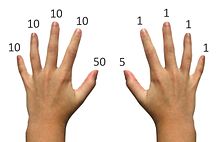Chisanbop
Chisanbop or Chisenbop (from Korea ) chi (ji finger + sanpŏp (sanbeop) arithmetic), Korean 지산 법 (指算法), a finger calculation method with which one basic arithmetic operations such as counting or basic arithmetic can perform. It is similar to calculating with the abacus .
According to The Complete Book of Chisanbop (see literature ), this method was invented by the Korean Sung Jin Pai in the late 1940s and simplified by his son Hang Young Pai so that it could also be successfully taught to young children. Around 1977 Hang Young Pai brought the method to the United States , from where it spread to Canada , Mexico , Australia, and Europe and gained millions of followers.
method
When chisanbop, both hands are held loosely over a table top; in the basic position no finger touches the table. A numerical value is displayed by pressing one or more fingers on the tabletop. The basic position (no finger touches the table top) corresponds to zero .
notation
In the following, a distinction is made ( anatomically not entirely correct) between the “thumb” and the other four “fingers”. The following notation is used for the position of the fingers or thumbs in relation to the table :
o← Finger on the table
.← Finger lifted from the table
@← Thumb on the table
-← Thumb lifted from the table
In the case of the right hand, for example @oo.., this means that the thumb, index and middle finger are on the table, while the ring and little fingers are lifted off the table.
Coding of decimal numbers
The fingers and thumbs of both hands can be used to encode the decimal numbers from 0 to 99, inclusive. The fingers and thumbs are assigned different values (see picture). When displaying a two-digit decimal number, the digits of the ones place are coded with the right hand:
-.... = 0 -o... = 1 -oo.. = 2 -ooo. = 3 -oooo = 4 @.... = 5 @o... = 6 @oo.. = 7 @ooo. = 8 @oooo = 9
The left hand takes over the tens place if necessary (for numbers up to 9 it represents ....-the " leading zero ", so to speak ):
....- = 00 ...o- = 10 ..oo- = 20 .ooo- = 30 oooo- = 40 ....@ = 50 ...o@ = 60 ..oo@ = 70 .ooo@ = 80 oooo@ = 90
Examples of coding two-digit decimal numbers with both hands:
....- -ooo. = 03 ..oo- @oo.. = 27 ....@ -oooo = 54 .ooo@ @o... = 86
Simple arithmetic
counting
When counting, the successive numerical values are simply represented one after the other with the hands. In each case, resulting transfers if multiples are achieved by the fifth Example counting from 1 to 11:
....- -o... = 01 ....- -oo.. = 02 ....- -ooo. = 03 ....- -oooo = 04 ....- @.... = 05 -> Übertrag zu 5: Daumen rechts setzen, Finger rechts löschen ....- @o... = 06 ....- @oo.. = 07 ....- @ooo. = 08 ....- @oooo = 09 ...o- -.... = 10 -> Übertrag zu 10: Zeigefinger links setzen, rechts Daumen und alle Finger löschen ...o- -o... = 11
addition
An arithmetic operation that is particularly easy to perform is addition . A number B is added to the number A by adding one to A starting from B (transfer formation as above) and reading the result from the hands.
Example 18 + 4:
...o- @ooo. = 18 ...o- @oooo = 18 + 1 ..oo- -.... = 18 + 2 -> Übertrag ..oo- -o... = 18 + 3 ..oo- -oo.. = 18 + 4 -> Resultat 22 ablesen
If there are more than two addends and more than two-digit decimal numbers, this works just like the written addition. In Chisanbop - starting with the ones - both hands add column by column, with the left hand creating the carryover to the next column. This is then mentally “written” over this column before the same procedure is used with this and all other columns.
All other basic arithmetic operations ( subtraction , multiplication and division ) can also be carried out with Chisanbop.
See also
Individual evidence
- ↑ Chisanbop. Dictionary.com, accessed December 30, 2015 .
- ↑ Pai 1981, p
- ↑ Pai 1981, p. Vi
- ↑ Pai 1981, p
literature
- Hang Young Pai: The Complete Book of Chisanbop: Original Finger Calculation Method Created by Sung Jin Pai and Hang Young Pai . Van Nostrand Reinhold, New York, Scarborough, Mitcham, Wokingham 1981, ISBN 0-442-27568-4 .
Web links
Interactive illustrations of number display and counting with Chisanbop in English:
- interactive demo by Jo Edkins
- interactive demo at Indiana University-Purdue University Indianapolis
- interactive demo at the Massachusetts Institute of Technology ( Scratch , Adobe Flash required)

